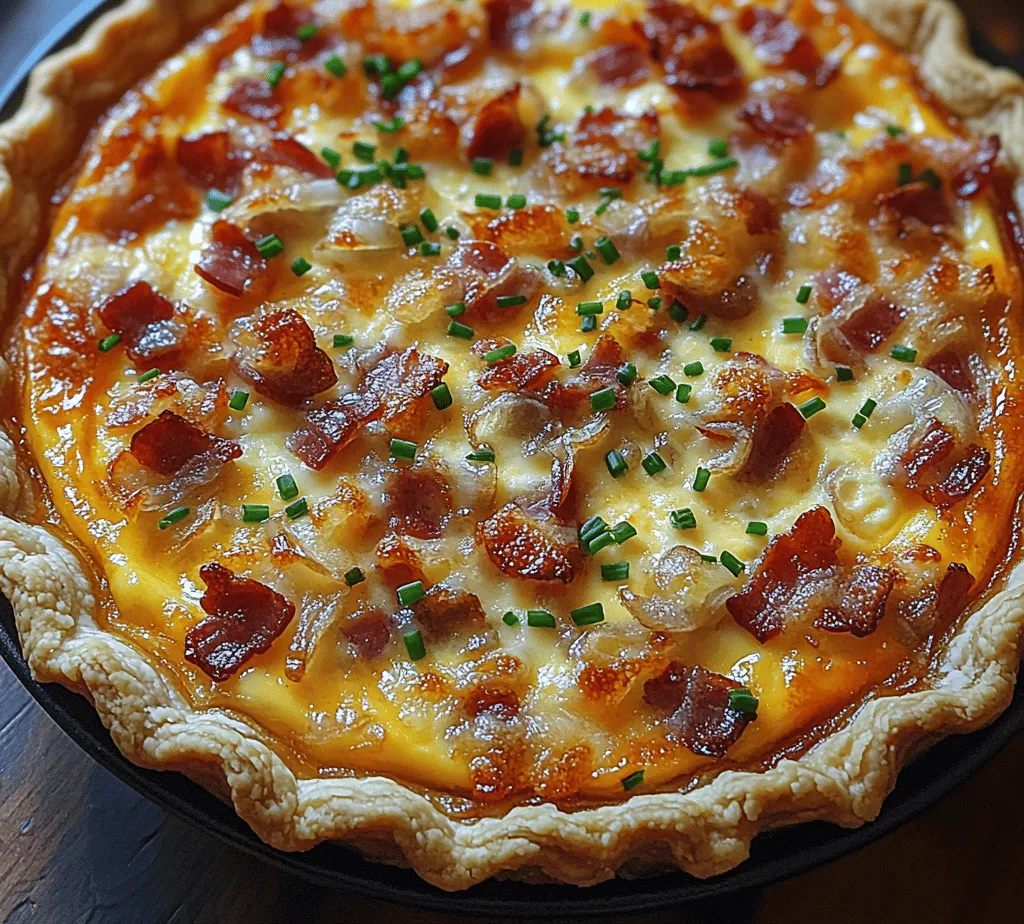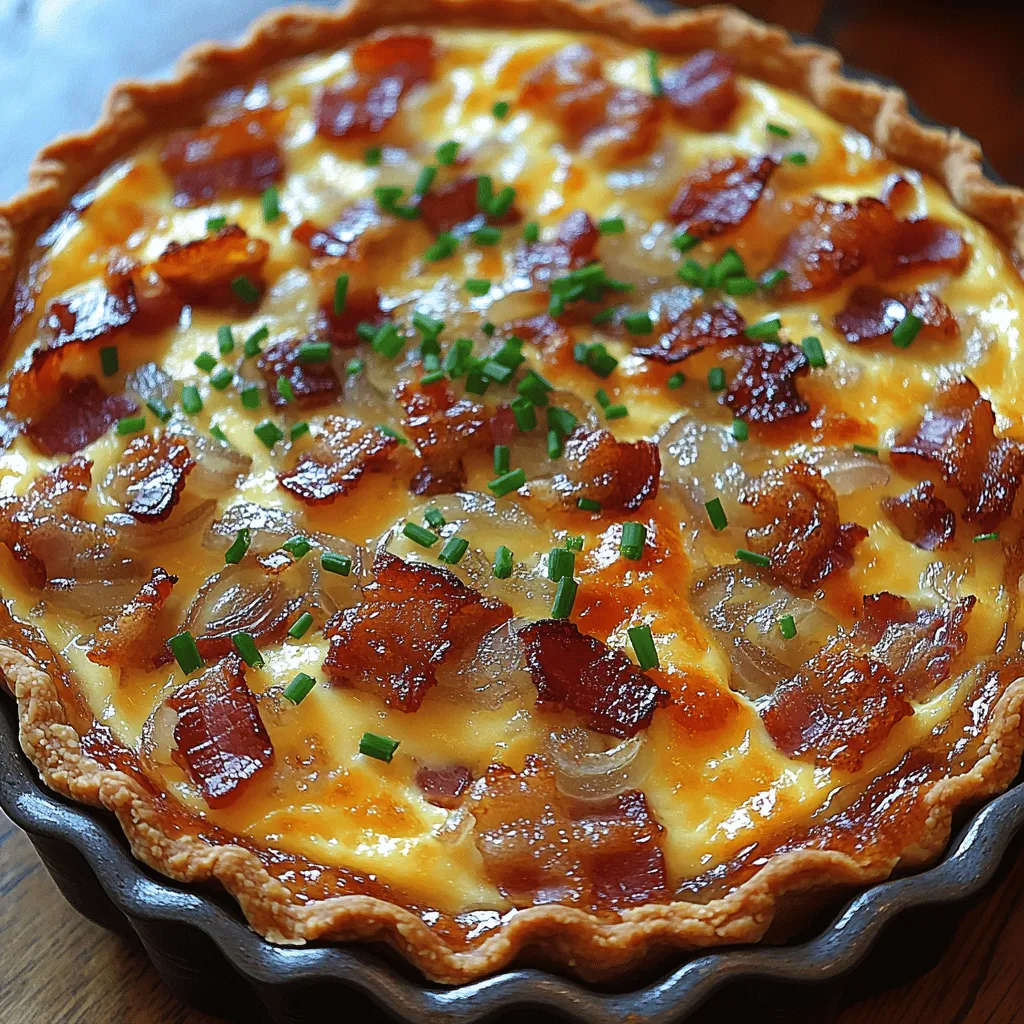Introduction
Quiche Lorraine is a classic French dish that has captivated food lovers around the world with its rich flavors and creamy texture. This savory pie is not just a meal; it’s an experience, combining a delightful filling of eggs, cream, and cheese, enriched by crispy bacon and sautéed onions, all encased in a flaky, buttery pie crust. Whether served at a leisurely brunch, a light lunch, or as a comforting dinner, Quiche Lorraine proves to be versatile and satisfying in every setting. In this article, we will explore the intricacies of making this beloved recipe, delve into its history, and provide tips for perfecting your own quiche at home.
The Origins of Quiche Lorraine
The Historical Significance of Quiche Lorraine
Quiche Lorraine has its roots in the Lorraine region of France, an area known for its rich culinary heritage. The name “quiche” is derived from the German word “kuchen,” meaning cake. Originally, the dish was a simple open pie filled with eggs and cream, with the addition of various ingredients over time. The classic version we know today, featuring bacon, began to take shape in the 18th century.
Historically, quiche was a peasant dish, utilizing leftover ingredients, making it a practical choice for families. Over the years, it evolved into a staple of French cuisine, gracing the tables of both humble homes and elegant bistros. Its popularity surged in the mid-20th century, especially in the United States, where it became a trendy brunch item and a symbol of sophisticated dining.
The Evolution of Quiche in French Cuisine
As quiche spread across France and beyond, various adaptations emerged, with each region adding its unique twist. From the rich seafood variations of Brittany to the vegetable-filled versions found in Provence, quiche has transformed into a canvas for creativity. The Quiche Lorraine, however, remains the classic, celebrated for its simplicity and the harmonious balance of its ingredients.
Regional Variations of Quiche Across France
While Quiche Lorraine stands out, it’s worth noting that France boasts a plethora of quiche variations. In Alsace, for example, you might find a quiche made with smoked salmon and leeks, while in Provence, ratatouille might take center stage. These regional interpretations highlight the versatility of quiche, allowing it to adapt to seasonal ingredients and local culinary traditions. However, the essence of the original Quiche Lorraine—its creamy, custard-like filling and crisp pastry—continues to capture the hearts of many.
Understanding the Key Ingredients
To master the art of making Quiche Lorraine, it is crucial to understand the key ingredients that contribute to its signature taste and texture. Here’s a closer look at what you’ll need:
Overview of Essential Ingredients for Quiche Lorraine
The beauty of Quiche Lorraine lies in its simplicity. The essential ingredients include:
– Eggs: The foundation of the filling, providing structure and richness.
– Heavy cream and milk: Together, they create a creamy, custard-like texture.
– Gruyère or Swiss cheese: Adds depth of flavor and a delightful melt.
– Bacon: For that savory, smoky flavor that defines the dish.
– Onions: Sautéed to bring sweetness and complexity.
– Seasonings: A touch of salt, pepper, and nutmeg for enhanced flavor.
The Role of Eggs in Achieving the Perfect Texture
Eggs are the backbone of any quiche, serving as the primary source of protein and providing the necessary structure for the filling. The ideal ratio of eggs to liquid is crucial in achieving that perfect custard-like texture. A common guideline is to use one egg for every half cup of cream or milk. This balance ensures that the filling sets properly without becoming too firm or overly runny.
Importance of Dairy: Heavy Cream and Whole Milk
The combination of heavy cream and whole milk is key to creating a luscious filling. Heavy cream contributes to a rich, velvety texture, while whole milk lightens the mixture slightly, preventing it from becoming overly dense. The fat content in the cream also enhances the flavor, making each bite indulgent and satisfying. For those looking to lighten the recipe, half-and-half or a combination of low-fat milk and cream can be used, but be mindful that this may alter the richness of the final product.
Choosing the Right Cheese: Gruyère vs. Swiss
Choosing the right cheese is essential for achieving the classic flavor profile of Quiche Lorraine. Gruyère cheese is a traditional choice, known for its nutty, slightly sweet flavor and excellent melting properties. It adds a depth of character to the quiche that complements the richness of the eggs and cream. Swiss cheese is another popular option that offers a milder taste. Feel free to experiment with other cheeses like cheddar or feta for a unique twist, but keep in mind that this will change the flavor profile of the dish.
The Flavorful Contribution of Bacon and Onions
Bacon is a quintessential element in Quiche Lorraine, delivering a savory, smoky note that balances the creaminess of the filling. Using high-quality bacon, preferably thick-cut, will yield the best results. The bacon should be cooked until crispy, allowing it to render its fat, which can also be used to sauté the onions.
Onions, when sautéed until soft and golden, add a subtle sweetness and depth of flavor to the quiche. They help to round out the dish, making it more complex and satisfying. Consider using shallots for a milder, sweeter flavor or adding herbs like thyme for an extra layer of taste.
The Subtlety of Seasonings: Dijon Mustard, Salt, and Nutmeg
The right seasonings are crucial for enhancing the flavors of the ingredients without overwhelming them. A small amount of Dijon mustard can be whisked into the egg mixture, providing a slight tang that complements the richness of the filling.
Salt and freshly ground black pepper are essential for bringing out the flavors of the other ingredients. Nutmeg, while used sparingly, adds a warm, aromatic note that elevates the overall flavor of the quiche. Always remember to taste the filling before baking, adjusting the seasoning as necessary.
Step-by-Step Guide to Making Quiche Lorraine
Now that we’ve explored the history and key ingredients of Quiche Lorraine, it’s time to dive into the step-by-step process of making this delicious dish. Preparing your workstation and understanding each step will help ensure your quiche turns out perfectly.
Prepping Your Workstation for a Seamless Cooking Experience
Before you begin, it’s essential to prepare your workstation. Gather all the necessary ingredients and tools, including:
– A 9-inch pie dish or tart pan
– Mixing bowls
– Whisk
– Frying pan
– Rolling pin (if making your own pie crust)
– Measuring cups and spoons
Having everything organized will streamline the cooking process and prevent any last-minute scrambling for ingredients.
Preheating the Oven: Why Temperature Matters
One of the first steps in making a perfect Quiche Lorraine is preheating your oven to 375°F (190°C). Preheating is crucial as it ensures that the quiche bakes evenly and sets properly. An oven that is too cool can result in a soggy crust, while one that is too hot may cause the filling to curdle or the crust to burn.
Once the oven is preheated, you can proceed with preparing the crust and the filling.
—
This detailed introduction and overview provide a foundation for your journey into making a delicious Quiche Lorraine. Stay tuned for the next steps, where we will guide you through the process of creating this timeless dish from scratch.

Preparing the Pie Crust: Techniques for Success
The foundation of a great Quiche Lorraine is undoubtedly its crust. A well-made pie crust ensures a flaky, buttery base that complements the rich filling. To achieve this, start by using cold butter. Cold ingredients help to create a flaky texture, as they prevent the development of gluten in the flour.
1. Choosing Your Flour: Opt for all-purpose flour for a tender crust, or you can use a mix of all-purpose and whole wheat for added flavor and nutrition.
2. Cutting in the Butter: Use a pastry cutter or your fingers to cut the cold butter into the flour until it resembles coarse crumbs. This method is crucial for achieving that desired flakiness.
3. Adding Water: Gradually add ice water, one tablespoon at a time, mixing until the dough just comes together. Avoid overworking the dough to ensure it remains tender.
4. Chilling: Wrap the formed dough in plastic wrap and refrigerate for at least 30 minutes. This step relaxes the gluten, making it easier to roll out.
5. Rolling: When ready to bake, roll out the chilled dough on a floured surface to about 1/8 inch thick. Transfer it to a pie dish, pressing it gently into the corners and trimming any excess.
Blind Baking Explained: Importance for Texture
Blind baking is a crucial technique when making a quiche. This process involves pre-baking the crust before adding the filling, which helps to prevent a soggy bottom.
1. Preheat the Oven: Preheat your oven to 375°F (190°C).
2. Prepare the Crust: Line your pie crust with parchment paper and fill it with pie weights or dried beans. This will prevent it from puffing up while baking.
3. Bake: Place the crust in the preheated oven and bake for about 15 minutes. Remove the weights and parchment and bake for an additional 5 to 10 minutes until the crust is lightly golden.
This technique ensures that the crust maintains its structure when the creamy filling is added, resulting in a perfect quiche.
Cooking Bacon to Perfection: Tips and Tricks
Bacon is one of the signature ingredients in Quiche Lorraine, contributing a wonderful smoky flavor. To cook bacon perfectly for your quiche, follow these steps:
1. Choosing the Right Bacon: Select high-quality bacon, preferably thick-cut for a better texture.
2. Cooking Method: For even cooking, place the bacon in a cold skillet and turn the heat to medium. This allows the fat to render slowly, resulting in crispy yet tender bacon.
3. Timing: Cook the bacon for about 8-10 minutes, flipping occasionally until golden brown and crisp. Drain on paper towels to remove excess fat before chopping it into bite-sized pieces.
Sautéing Onions: Achieving the Right Flavor Profile
Sautéed onions add sweetness and depth to the quiche filling. Here’s how to achieve perfectly caramelized onions:
1. Choosing Your Onions: Yellow onions are ideal for their balance of sweetness and sharpness, but you can also use shallots for a more delicate flavor.
2. Cooking: In a skillet, heat a tablespoon of olive oil or butter over medium heat. Add the sliced onions and a pinch of salt.
3. Caramelizing: Cook the onions gently, stirring occasionally, until they become soft and golden, about 15-20 minutes. This slow cooking enhances their sweetness, enriching the overall flavor of the quiche.
Creating the Egg Mixture: Whisking for Optimal Incorporation
The egg mixture is where the magic happens in a Quiche Lorraine. Here’s how to make it smooth and flavorful:
1. Using Fresh Eggs: Fresh eggs yield the best flavor and texture. Crack 4-6 large eggs into a mixing bowl.
2. Adding Dairy: Whisk in heavy cream or a mix of cream and milk (about 1 cup total). This adds richness to the filling.
3. Seasoning: Season the mixture generously with salt, pepper, and a dash of nutmeg to bring out the flavors. Whisk until fully combined and slightly frothy, ensuring a light and airy quiche.
Layering Ingredients: The Art of Assembly
Assembling your quiche is where you can get creative. Here’s the proper way to layer your ingredients for optimal flavor distribution:
1. Base Layer: Start by evenly distributing the cooked bacon and sautéed onions over the blind-baked crust.
2. Cheese Addition: Sprinkle a layer of grated cheese (Gruyère or Swiss) over the bacon and onions. This not only adds flavor but also helps to bind the filling.
3. Pouring the Egg Mixture: Gently pour the egg mixture over the layered ingredients, ensuring that it seeps into all the nooks and crannies.
Baking the Quiche: Timing and Temperature Tips
Baking your quiche to perfection requires attention to timing and temperature:
1. Setting the Oven: Bake the quiche in a preheated oven at 375°F (190°C) for 30-40 minutes.
2. Checking for Doneness: The quiche is done when the edges are set, but the center should still have a slight jiggle. If it’s browning too quickly, cover the edges with foil to prevent burning.
3. Cooling: Once baked, allow the quiche to cool for at least 10-15 minutes before slicing. This resting period helps the filling to set, making it easier to cut clean slices.
Cooling and Serving: Best Practices for Presentation
Serving your Quiche Lorraine beautifully can enhance the dining experience. Here are some presentation tips:
1. Cooling: After baking, let the quiche cool on a wire rack. This prevents moisture from collecting at the bottom.
2. Plating: When ready to serve, use a sharp knife to slice the quiche into wedges. Serve warm or at room temperature on a beautiful platter.
3. Garnishing: A sprinkle of fresh herbs, such as chives or parsley, adds a pop of color and freshness to the presentation.
Enhancing Your Quiche Experience
To elevate your Quiche Lorraine further, consider these enhancements:
Garnishing Ideas: Elevating Presentation with Herbs
Fresh herbs can add both flavor and visual appeal to your quiche. Consider garnishing with:
– Chopped Chives: These offer a mild onion flavor that complements the quiche beautifully.
– Fresh Parsley: Adds a vibrant green color and a fresh taste.
– Thyme or Rosemary: A sprinkle of these herbs can provide an aromatic touch.
Pairing Suggestions: What to Serve with Quiche Lorraine
To create a complete meal, consider serving your Quiche Lorraine with:
– Mixed Green Salad: A light salad with a vinaigrette can balance the richness of the quiche.
– Roasted Vegetables: Seasonal roasted veggies add color and nutrition to your plate.
– Fresh Fruit: Slices of seasonal fruit can provide a refreshing contrast and a hint of sweetness.
Storing and Reheating Leftovers: Tips for Maintaining Freshness
If you have leftover quiche, proper storage is essential for maintaining its quality:
1. Storing: Cover the quiche with plastic wrap or foil and refrigerate for up to 3 days.
2. Reheating: To reheat, place slices in a preheated oven at 350°F (175°C) for about 15-20 minutes, or until heated through. This helps retain the crust’s crispiness.
Variations of Quiche Lorraine
Quiche Lorraine is versatile and can be adapted to suit different tastes and dietary needs:
Exploring Alternative Ingredients for Different Diets
If you’re looking for alternatives to traditional ingredients, consider:
– Plant-Based Bacon: There are excellent vegan options available that mimic the flavor of bacon without the meat.
– Dairy-Free Cream: Use coconut cream or cashew cream for a dairy-free version.
Vegetarian Adaptations: Creative Substitutions
For a vegetarian take on Quiche Lorraine, you can replace the bacon with:
– Mushrooms: Sautéed mushrooms add a savory, umami flavor.
– Spinach: Fresh or cooked spinach can provide a nutritious boost.
Global Influences: Quiche Variations Inspired by World Cuisines
Explore international flavors by swapping ingredients:
– Spanish Tortilla: Replace the bacon with potatoes and add bell peppers for a Spanish twist.
– Mediterranean Quiche: Incorporate feta cheese, olives, and sun-dried tomatoes for a Mediterranean flair.
Conclusion
Quiche Lorraine is not just a dish; it’s a culinary experience that brings together rich flavors and textures in a delightful way. Whether enjoyed during a special occasion or as a comforting meal at home, this classic recipe is sure to impress. By understanding its history, mastering the key ingredients, and following the step-by-step guide, anyone can create a delicious quiche that is both satisfying and memorable. Embrace the art of quiche-making and savor the joy it brings to your table.

